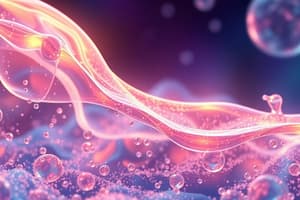Podcast
Questions and Answers
What are the two fractions of DCD identified in the beads?
What are the two fractions of DCD identified in the beads?
- Organic DCD and inorganic DCD
- Soluble DCD and insoluble DCD
- Available DCD and locked DCD (correct)
- Free DCD and complexed DCD
Which technique was used for bead morphology and surface analyses?
Which technique was used for bead morphology and surface analyses?
- Atomic force microscopy (AFM)
- Transmission electron microscopy (TEM)
- Scanning electron microscopy (SEM) (correct)
- X-ray diffraction (XRD)
What was the retention time of the second compound detected in beads incubated in water?
What was the retention time of the second compound detected in beads incubated in water?
- 4.0 min
- 5.2 min
- 6.3 min
- 4.6 min (correct)
What mode of analysis was used to quantify the DCD content in samples?
What mode of analysis was used to quantify the DCD content in samples?
What was the effect of acidification on the release of the glyoxal derivative?
What was the effect of acidification on the release of the glyoxal derivative?
What statistical method was employed to investigate the effects of independent variables?
What statistical method was employed to investigate the effects of independent variables?
What did the results indicate about the glyoxal-DCD adduct's hydrolysis?
What did the results indicate about the glyoxal-DCD adduct's hydrolysis?
How much more glyoxal-DCD adduct did CG beads release compared to C beads?
How much more glyoxal-DCD adduct did CG beads release compared to C beads?
What is the main component of chitosan that results from its deacetylation?
What is the main component of chitosan that results from its deacetylation?
What was the percentage increase in the initial dry weight of CG beads compared to C beads?
What was the percentage increase in the initial dry weight of CG beads compared to C beads?
What property of chitosan allows for a high rate of wetting?
What property of chitosan allows for a high rate of wetting?
What reaction can glyoxal undergo upon loss of water?
What reaction can glyoxal undergo upon loss of water?
How can DCD be extracted from chitosan xerogel beads?
How can DCD be extracted from chitosan xerogel beads?
What kind of adducts might glyoxal form with the guanidine group of DCD?
What kind of adducts might glyoxal form with the guanidine group of DCD?
What was the significant difference in DCD content between C beads and CG beads?
What was the significant difference in DCD content between C beads and CG beads?
How did acidification affect DCD extraction from CG beads?
How did acidification affect DCD extraction from CG beads?
What was one example of an agrochemical delivered using chitosan-derived systems?
What was one example of an agrochemical delivered using chitosan-derived systems?
What was the method used to extract DCD from the beads?
What was the method used to extract DCD from the beads?
What analysis method was used to measure the quantity of DCD extracted from the beads?
What analysis method was used to measure the quantity of DCD extracted from the beads?
What hypothesis can be made regarding glyoxal-DCD adducts under acidic conditions?
What hypothesis can be made regarding glyoxal-DCD adducts under acidic conditions?
What was the total DCD content per bead for C beads during the experiments?
What was the total DCD content per bead for C beads during the experiments?
What factor caused the swelling of the beads during acidification?
What factor caused the swelling of the beads during acidification?
What was the main purpose of investigating DCD release kinetics from the beads?
What was the main purpose of investigating DCD release kinetics from the beads?
What effect did the incubation of DCD solutions have under similar conditions to the bead study?
What effect did the incubation of DCD solutions have under similar conditions to the bead study?
What role does chitosan play in the release of dicyandiamide (DCD)?
What role does chitosan play in the release of dicyandiamide (DCD)?
What is one of the main benefits of using nitrification inhibitors like DCD in agricultural systems?
What is one of the main benefits of using nitrification inhibitors like DCD in agricultural systems?
How does glyoxal polymerisation affect the DCD encapsulation in chitosan beads?
How does glyoxal polymerisation affect the DCD encapsulation in chitosan beads?
What happens to the DCD release profile when excess glyoxal is partly removed?
What happens to the DCD release profile when excess glyoxal is partly removed?
What was the primary investigation focus of the study regarding DCD?
What was the primary investigation focus of the study regarding DCD?
What type of release characteristics do the chitosan beads impart to DCD?
What type of release characteristics do the chitosan beads impart to DCD?
Which of the following statements about the hydrogel used in the study is correct?
Which of the following statements about the hydrogel used in the study is correct?
What environmental impact does the use of nitrification inhibitors aim to address?
What environmental impact does the use of nitrification inhibitors aim to address?
What percentage of DCD content was lost by C beads after 9 hours in deionised water?
What percentage of DCD content was lost by C beads after 9 hours in deionised water?
Which type of bead retained a larger proportion of DCD content over 14 days?
Which type of bead retained a larger proportion of DCD content over 14 days?
What was the percentage of DCD content released by CG beads after 14 days?
What was the percentage of DCD content released by CG beads after 14 days?
What does the glyoxal-crosslinked chitosan indicate about its ability to hold DCD content?
What does the glyoxal-crosslinked chitosan indicate about its ability to hold DCD content?
After 14 days, what was the total fraction of DCD content released by C beads?
After 14 days, what was the total fraction of DCD content released by C beads?
What does the data suggest about the locked DCD fractions in C beads?
What does the data suggest about the locked DCD fractions in C beads?
Which beads showed a rapid release of DCD before reaching a plateau?
Which beads showed a rapid release of DCD before reaching a plateau?
What was the DCD content release percentage of CG beads after 9 hours?
What was the DCD content release percentage of CG beads after 9 hours?
What is the primary reason CG beads are heavier than C beads?
What is the primary reason CG beads are heavier than C beads?
What happens to the locked fraction of DCD after acidification?
What happens to the locked fraction of DCD after acidification?
What role does glyoxal play in the structure of chitosan beads?
What role does glyoxal play in the structure of chitosan beads?
What implication does glyoxal's ability to polymerize have on DCD release?
What implication does glyoxal's ability to polymerize have on DCD release?
What could be inferred about glyoxal derivatives in the beads?
What could be inferred about glyoxal derivatives in the beads?
What aspect of glyoxal in chitosan has not been reported?
What aspect of glyoxal in chitosan has not been reported?
What does the study suggest about the interaction of glyoxal with chitosan?
What does the study suggest about the interaction of glyoxal with chitosan?
Why is it significant to understand the polymerization of glyoxal in chitosan beads?
Why is it significant to understand the polymerization of glyoxal in chitosan beads?
Flashcards
Nitrification inhibitor
Nitrification inhibitor
A chemical that slows down a process in soil called nitrification
Dicyandiamide (DCD)
Dicyandiamide (DCD)
A specific nitrification inhibitor used in agriculture
Chitosan hydrogel
Chitosan hydrogel
A biodegradable material that releases DCD slowly over time
Glyoxal crosslinking
Glyoxal crosslinking
Signup and view all the flashcards
Controlled DCD release
Controlled DCD release
Signup and view all the flashcards
DCD encapsulation
DCD encapsulation
Signup and view all the flashcards
Chitosan beads
Chitosan beads
Signup and view all the flashcards
Soil nitrification
Soil nitrification
Signup and view all the flashcards
Chitin
Chitin
Signup and view all the flashcards
Chitosan
Chitosan
Signup and view all the flashcards
Hydrogel
Hydrogel
Signup and view all the flashcards
Crosslinking
Crosslinking
Signup and view all the flashcards
Glyoxal
Glyoxal
Signup and view all the flashcards
DCD Release Mechanism
DCD Release Mechanism
Signup and view all the flashcards
Schiff Base
Schiff Base
Signup and view all the flashcards
Advantages of Chitosan DCD
Advantages of Chitosan DCD
Signup and view all the flashcards
DCD Fraction
DCD Fraction
Signup and view all the flashcards
DCD Release Rate
DCD Release Rate
Signup and view all the flashcards
Glyoxal-DCD Adduct
Glyoxal-DCD Adduct
Signup and view all the flashcards
Acidification Effect
Acidification Effect
Signup and view all the flashcards
CG Bead Release
CG Bead Release
Signup and view all the flashcards
HPLC Retention Time
HPLC Retention Time
Signup and view all the flashcards
Bead Morphology
Bead Morphology
Signup and view all the flashcards
DCD Quantification
DCD Quantification
Signup and view all the flashcards
What is DCD?
What is DCD?
Signup and view all the flashcards
What is the main difference between C and CG beads?
What is the main difference between C and CG beads?
Signup and view all the flashcards
How does acidification affect DCD release?
How does acidification affect DCD release?
Signup and view all the flashcards
Why is the amount of DCD extracted reliable?
Why is the amount of DCD extracted reliable?
Signup and view all the flashcards
What is the role of swelling in DCD release?
What is the role of swelling in DCD release?
Signup and view all the flashcards
What is the significance of DCD stability?
What is the significance of DCD stability?
Signup and view all the flashcards
How does DCD release from beads relate to soil?
How does DCD release from beads relate to soil?
Signup and view all the flashcards
How is DCD release from beads assessed in soil?
How is DCD release from beads assessed in soil?
Signup and view all the flashcards
Crosslinking Density
Crosslinking Density
Signup and view all the flashcards
Chitosan/Glyoxal Beads
Chitosan/Glyoxal Beads
Signup and view all the flashcards
Why Glyoxal?
Why Glyoxal?
Signup and view all the flashcards
DCD Release in Water
DCD Release in Water
Signup and view all the flashcards
C Beads vs. CG Beads
C Beads vs. CG Beads
Signup and view all the flashcards
DCD Fraction Released
DCD Fraction Released
Signup and view all the flashcards
Glyoxal Crosslinking Effect
Glyoxal Crosslinking Effect
Signup and view all the flashcards
Locked DCD Fraction
Locked DCD Fraction
Signup and view all the flashcards
Chitosan's DCD Holding Power
Chitosan's DCD Holding Power
Signup and view all the flashcards
DCD Release Plateau
DCD Release Plateau
Signup and view all the flashcards
Benefits of Slow DCD Release
Benefits of Slow DCD Release
Signup and view all the flashcards
Study Notes
Nitrification Inhibitor Delivery Using Chitosan Hydrogel
- Dicyandiamide (DCD) encapsulated in glyoxal-crosslinked chitosan hydrogel beads to control release in water and soil.
- Chitosan hydrogel delays DCD release, controlled by glyoxal crosslinking.
- Higher glyoxal polymerization leads to slower DCD release, but also lower encapsulation.
- DCD release in water is controlled by quasi-Fickian diffusion.
- Release in water is primarily governed by bead erosion and leaching of glyoxal derivatives (primarily a glyoxal-DCD adduct).
- Chitosan/glyoxal composite beads show promise for slow-release of agrochemicals, like DCD in soil.
DCD Encapsulation and Release
- DCD encapsulated in chitosan beads with varying glyoxal crosslinking (C beads vs CG beads).
- C beads (partially removed excess glyoxal) released higher DCD amounts (84% in 9h water/ 74-98% in 7d soil).
- CG beads (dried with excess glyoxal) released much lower DCD amounts (19% in 9h water/ 33% in 7d soil with high rainfall).
- Release is a two-stage process: quick release of available DCD, followed by slower release of locked DCD.
- Release controlled by bead erosion and leaching of glyoxal-DCD adducts.
DCD Release in Soil
- DCD release in soil is prolonged, especially in high rainfall conditions.
- Release is initially slow, then increases over time (low, medium, high rainfall rates).
- Rainfall/soil moisture affects release rate.
- C beads release substantially more DCD than CG beads, especially under high-rainfall conditions.
Chitosan Hydrogel Properties
- Chitosan is a biodegradable polymer extracted from crustacean shells.
- Highly porous and hydrophilic, allowing for fast wetting.
- Controlled release of encapsulated compounds based on cross-linking density and pore size.
- Used for controlled drug delivery and other applications.
Overall Findings
- Chitosan hydrogel provides a slow-release system for nitrification inhibitors, potentially reducing environmental impact and need for repeated applications.
- The glyoxal content in the hydrogel plays a key role in controlling DCD release rates.
- Soil moisture and rainfall affect the release profile significantly.
Studying That Suits You
Use AI to generate personalized quizzes and flashcards to suit your learning preferences.




